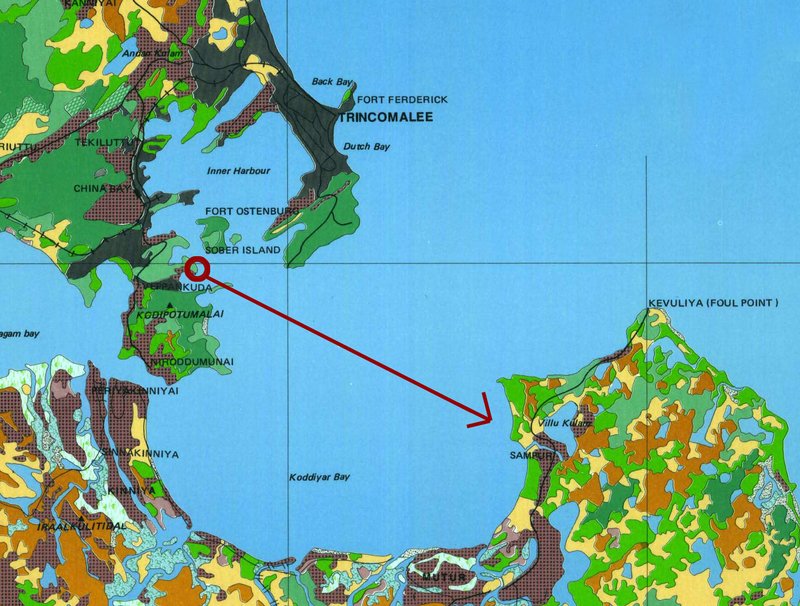 |
| Site proposed by the Sinhala government for the coal power plant. |
In a surprise development, India has agreed to build Sri Lanka’s proposed second coal power plant in Sampur, the site originally proposed the Sinhala government, partners in the joint-venture, the Sunday Times reported.
Last week the Ceylon Electricity Board (CEB) and India’s National Thermal Power Corporation (NTPC) shook hands in New Delhi over India’s acceptance of the site, according to a well-placed CEB source.
While NTPC Chairman Ram Charan Sharma told the media that the 500-MW thermal power project in Trincomalee district will be one of the largest infrastructure investment in Sri Lanka, residents and rights activists complained that the Indian decision to pick that site for the power project had added to the misery of Tamil people displaced from there.
The controversial site is in the North Eastern province, across the Koddiyar Bay from Trincomalee. Sampur is a large and populous fishing village overlooking the famous port.
The two countries signed an agreement in December 2006, after the Sri Lanka Army captured Sampur from the LTTE in September that year, driving thirty thousand Tamils from their homes.
However, the location of the plant in Sampur became an issue, with the Tamil National Alliance (TNA) raising political and environmental objections.
Under the agreement, NTPC is to soon launch a feasibility study on the proposed 500MW plant, estimated to cost US$500 million, while Sri Lanka will conduct a survey and secure 500 acres in Sampur for the project.
Sources told the Sunday Times there was plenty of government land in Sampur to accommodate the project, adding that no persons would be displaced by the project because the area comes within a high security zone.
Accommodation would be found for any persons who had been displaced earlier because of the proposed project, the government claims.
However, the Tamil National Alliance alleged that there was a hidden agenda to the project to permanently evict Tamils from the Muttur east region.
The TNA claims that about 30,000 Tamils were forced to leave the southern Trincomalee region when the military launched a major operation in 2006 to retake the area.
The advocates of power plant in Sampoor region seem to think that a military victory alone would not be sufficient, in the long run, to evict Tamils permanently from the region.
Up to as recently as March this year, the CEB was busy trying to secure Veloor, a site north of Trincomalee town, for the joint-venture power project.
The NTPC had expressed a preference for a site that was near the Indian Oil Corporation complex. It is believed that Delhi’s sudden change of heart came after the CEB made it known that it would invite bids to build a third coal power plant at Sampur, where the Sri Lankan government was already making arrangements to build a jetty to unload coal for the second joint venture power project with the Indians.
The Sunday Times’ sources believe the Indians, fearing the presence of other powers in the strategic port region, had quickly decided to accept the CEB designated location.
The project, which is expected to be completed in May 2012, will see CEB and NTPC each taking an equity stake of US$75 million, while the balance money will be raised through borrowings, making a debt equity ratio of 70:30.
"Indian arguments that the coal-based plant is meant to benefit locals in Trincomalee are having no effect on rights activists and the thousands who fled the region after fighting between the Tamil Tigers and the military," IANS reported.
The NTPC project will affect a large number of people," the IANS report quoted K. Thurairatnasingham, a Tamil National Alliance (TNA) MP from Trincomalee, as saying.
"We have conveyed our feelings to Indian diplomats. Our people cannot accept this," he added.
"This is where our forefathers lived. It is the only land in a largely dry area with water resources suitable for cultivation.We are not saying we don't want the project. But why build it in an area that will force Tamils to give up for ever their ancestral land?"


